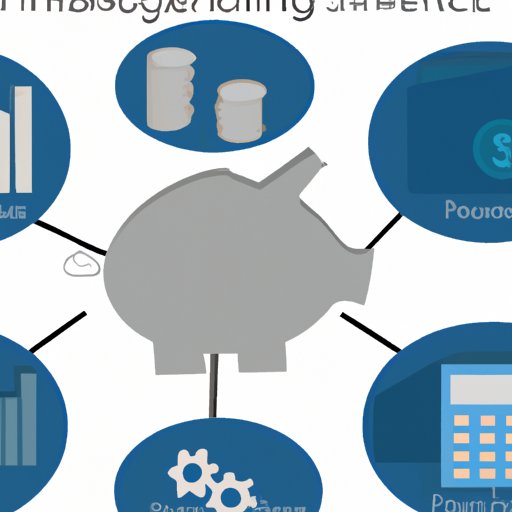Introduction
Financial independence is the ability to pay all necessary living expenses and save for retirement without relying on a regular paycheck. It involves having enough sources of income and resources to cover all your costs and put money aside for future goals. Reaching financial independence is a process that takes time and dedication, but it can be achieved through careful planning and disciplined effort.

Develop a Budget and Stick to It
The most important step to reach financial independence is to create and adhere to a budget. A budget helps you track your income and expenses, set spending limits, and identify areas where you can cut back. Having a budget also allows you to make sure you are saving enough for retirement and other long-term goals.
Benefits of Having a Budget
Creating a budget has several benefits. It gives you control over your finances and helps you make better decisions about how to spend and save your money. It also allows you to track your progress towards financial independence and identify areas where you can improve. Additionally, it helps you prioritize your goals and stick to them.
Tips for Creating and Adhering to a Budget
When creating a budget, start by calculating your income and expenses. Make sure to include all sources of income, such as wages, investments, and side hustles. Then, list out all of your expenses, including rent/mortgage, utilities, food, entertainment, etc. Once you have this information, you can start setting spending limits and tracking your progress. To stick to your budget, consider using budgeting apps or setting up automatic transfers to help you stay on track. Additionally, review your budget regularly and adjust it as needed.
Utilize Passive Income Streams
Passive income is any income that is earned without actively working for it. This type of income is generated from investments, rental properties, royalties, or other sources of income that require minimal effort to maintain. Investing in passive income streams is a great way to diversify your income and increase your earning potential.
What is Passive Income?
Passive income is any type of income that does not require active work to earn. Examples of passive income include dividends from stocks, rental income from real estate investments, and royalties from intellectual property. This type of income is often referred to as “unearned” because it is not directly associated with a job or labor.
Different Types of Passive Income
There are many different types of passive income. The most common types include interest from investments, rental income from real estate, royalties from books or music, and income from side hustles. Other forms of passive income include affiliate marketing, network marketing, and ecommerce.
How to Take Advantage of Passive Income
Taking advantage of passive income streams requires some research and legwork. First, you need to identify which type of income is best suited for your situation. Then, you need to take the necessary steps to set up the income stream, such as finding tenants for rental properties or opening up a brokerage account for stock investments. Once the stream is established, you can start to reap the rewards of the additional income.
Invest in Low-Cost Index Funds
Index funds are a type of mutual fund that tracks a specific market index, such as the S&P 500. These funds are typically low cost, meaning they have lower management fees than other mutual funds. Investing in index funds is a great way to diversify your portfolio and benefit from the long-term growth of the stock market.
Benefits of Low-Cost Index Funds
Low-cost index funds offer several advantages. They are easy to purchase and manage, since they track a specific index. Additionally, they provide diversification, since they contain a mix of stocks from different sectors. Finally, they are relatively low risk, since they track a broad market index rather than individual stocks.
How to Invest in Low-Cost Index Funds
Investing in low-cost index funds is relatively straightforward. First, you need to open a brokerage account with an online broker that offers index funds. Next, you need to select an index fund that fits your investment goals. Finally, you need to decide how much you want to invest and make the purchase. You can also opt to automate your investments to ensure you are consistently contributing to your index fund.
Cut Unnecessary Expenses
Cutting unnecessary expenses is another key step to reaching financial independence. Identifying and eliminating unnecessary expenses can free up more money for saving and investing. Additionally, it can help reduce stress and give you more control over your finances.
Identifying Unnecessary Expenses
To identify unnecessary expenses, start by reviewing your budget and look for areas where you can cut back. Consider if you really need to keep paying for certain services or subscriptions. Additionally, look for ways to save on groceries, transportation, and other everyday expenses.
Ways to Reduce Unnecessary Expenses
Once you have identified areas where you can cut back, there are several ways to reduce those expenses. For example, you can switch to a cheaper cell phone plan, shop around for better car insurance rates, or cancel subscription services you no longer use. Additionally, you can explore ways to save on groceries, such as buying in bulk or using coupons.
Automate Your Savings and Investments
Automating your savings and investments is another important step to reaching financial independence. Automation makes it easier to save and invest consistently, since the money is automatically transferred to the appropriate accounts. Additionally, it helps prevent impulse purchases and ensures you are staying on track with your financial goals.
Benefits of Automating Savings and Investments
Automating your savings and investments has several benefits. It eliminates the need to manually transfer funds, which saves time and reduces the chances of making a mistake. Additionally, it allows you to save and invest consistently, which is essential for long-term success. Finally, it prevents you from spending money impulsively, since the funds are already allocated.
How to Automate Savings and Investments
Setting up automated savings and investments is relatively easy. Most banks and online brokers offer the option to set up automatic transfers to designated accounts. Additionally, many employers offer direct deposit options that allow you to automatically transfer a portion of your paycheck to a savings or investment account. Finally, you can set up recurring transfers to ensure you are consistently contributing to your accounts.
Conclusion
Reaching financial independence is an achievable goal with careful planning and disciplined effort. The key steps to achieving financial independence include developing a budget and sticking to it, utilizing passive income streams, investing in low-cost index funds, cutting unnecessary expenses, and automating savings and investments. With these steps, you can take control of your finances and build a secure financial future.
(Note: Is this article not meeting your expectations? Do you have knowledge or insights to share? Unlock new opportunities and expand your reach by joining our authors team. Click Registration to join us and share your expertise with our readers.)
